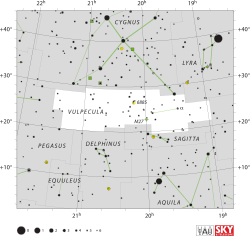| Observation data Epoch J2000 Equinox J2000 | |
|---|---|
| Constellation | Vulpecula |
| Right ascension | 19h 26m 13.2463s[1] |
| Declination | +20° 05′ 51.8394″[1] |
| Apparent magnitude (V) | 5.65±0.010[2] |
| Characteristics | |
| Spectral type | A0 V[3] |
| Apparent magnitude (U) | 5.62±0.012[2] |
| Apparent magnitude (B) | 5.66±0.011[2] |
| Astrometry | |
| Radial velocity (Rv) | −20.9±2.9[4] km/s |
| Proper motion (μ) | RA: +3.395±0.114[1] mas/yr Dec.: −34.787±0.137[1] mas/yr |
| Parallax (π) | 13.8921 ± 0.0900 mas[1] |
| Distance | 235 ± 2 ly (72.0 ± 0.5 pc) |
| Absolute magnitude (MV) | 1.29[5] |
| Details[3] | |
| Mass | 2.33±0.02 M☉ |
| Radius | 2.7[6] R☉ |
| Luminosity | 34±2 L☉ |
| Surface gravity (log g) | 4.0[7] cgs |
| Temperature | 9,840+91 −90 K |
| Rotational velocity (v sin i) | 154 km/s |
| Age | 198[7] Myr |
| Other designations | |
| Database references | |
| SIMBAD | data |
5 Vulpeculae is a single,[9] white-hued star in the northern constellation of Vulpecula.[8] It is situated amidst a random concentration of bright stars designated Collinder 399,[10] or Brocchi's Cluster. This is a faint star that is just visible to the naked eye with an apparent visual magnitude of 5.60.[4] Based upon an annual parallax shift of 13.8921±0.0900 mas,[1] it is located around 235 light years from the Sun. It is moving closer with a heliocentric radial velocity of −21 km/s,[4] and will make its closest approach in 2.5 million years at a separation of around 120 ly (36.89 pc).[5]
This is a young A-type main-sequence star with a stellar classification of A0 V.[3] It is a rapidly rotating star[11] with a projected rotational velocity of 154 km/s.[3] The star has an estimated 2.33[3] times the mass of the Sun and about 2.7[6] times the Sun's radius. It is radiating 34 times the Sun's luminosity from its photosphere at an effective temperature of 8,940 K.[3]
A warm debris disk was detected by the Spitzer Space Telescope at a temperature of 206 K (−89 °F; −67 °C), orbiting 13 Astronomical units from the host star.[12] Although this finding has not been directly detected, the emission signature indicates the disk is in the form of a thin ring. The emission displays weak transient absorption features that are indicative of kilometer-sized exocomets that are undergoing evaporation as they approach the host star.[11] These absorption features have been observed to vary on time scales of hours, days, or months.[13]
- ^ a b c d e f Cite error: The named reference
Gaia DR2was invoked but never defined (see the help page). - ^ a b c Cite error: The named reference
Harmanec2020was invoked but never defined (see the help page). - ^ a b c d e f Cite error: The named reference
zorec2012was invoked but never defined (see the help page). - ^ a b c Cite error: The named reference
Gontcharov2006was invoked but never defined (see the help page). - ^ a b Cite error: The named reference
Anderson2012was invoked but never defined (see the help page). - ^ a b Cite error: The named reference
cadarswas invoked but never defined (see the help page). - ^ a b Cite error: The named reference
Chen2014was invoked but never defined (see the help page). - ^ a b Cite error: The named reference
SIMBADwas invoked but never defined (see the help page). - ^ Cite error: The named reference
Eggleton2008was invoked but never defined (see the help page). - ^ Cite error: The named reference
Baumgardt1998was invoked but never defined (see the help page). - ^ a b Cite error: The named reference
Montgomery2012was invoked but never defined (see the help page). - ^ Cite error: The named reference
Morales2009was invoked but never defined (see the help page). - ^ Cite error: The named reference
Montgomery2014was invoked but never defined (see the help page).
